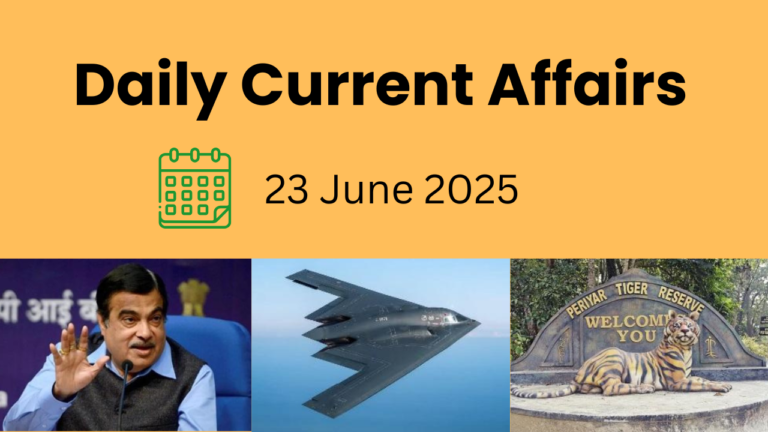1. PM’s State Visit to Mauritius: Strengthening Bilateral Ties and Regional Cooperation
Context: The Prime Minister of India recently completed a significant state visit to Mauritius, marking his second visit since 2015. During this visit, the Prime Minister was invited as the Chief Guest at Mauritius’ National Day Celebrations on March 12, an occasion that holds great significance as it commemorates the anniversary of Mahatma Gandhi’s Dandi March.
Key Highlights of the Visit:
- Memorandums of Understanding (MOUs) Signed: The visit resulted in the signing of several MOUs aimed at enhancing collaboration between the two nations. Key areas of focus include:
- Training for Civil Servants
- Support for Small and Medium Enterprises (SMEs)
- Development of the Blue Economy
- Combating Financial Crimes
- Local Currency Settlement for Trade
- Indian Rupee Credit Line: A landmark agreement was made with the announcement of a 487.6 crore INR credit line, marking the first-ever INR-based credit line for Mauritius. This line will be utilized for replacing water pipelines across the island nation.
- White-Shipping Agreement: The two countries signed a technical agreement focused on maritime security and the exchange of crucial maritime information.
- Prestigious Award Conferred: During the visit, the Prime Minister received the Grand Commander of the Order of the Star and Key of the Indian Ocean, a prestigious distinction that made him the first Indian to receive such an honor.
- Vision MAHASAGAR Unveiled: PM Modi introduced the Vision MAHASAGAR (Mutual And Holistic Advancement for Security And Growth Across Regions), building on the previous Vision SAGAR which focused on security and growth for all in the region.
About Mauritius: A Strategic Partner for India:
Location and Population: Mauritius is a strategically located island nation in the western Indian Ocean, close to India. Nearly 70% of the population (around 1.2 million people) have Indian origin, which forms the bedrock of the close ties between the two nations.
Colonial History: Mauritius has a rich colonial history, initially being a French colony before coming under British rule.
National Day Celebrations: March 12 marks Mauritius’ National Day, commemorating the date of Mahatma Gandhi’s Dandi March.
India-Mauritius Bilateral Relations: A Strong Partnership:
Diplomatic Relations: India and Mauritius have enjoyed strong diplomatic relations since 1948, making Mauritius a key trading partner in the Asian continent.
Commercial Ties: For FY 2022-2023
- Indian exports to Mauritius stood at USD 462.69 million.
- Mauritian exports to India were USD 91.50 million.
- Total trade between the two nations amounted to USD 554.19 million.
Key Agreements and Treaties:
- Double Taxation Avoidance Agreement (1982): Helps in avoiding double taxes for non-resident investors.
- Comprehensive Economic Cooperation and Partnership Agreement (CECPA): Signed in 2021, this was India’s first trade agreement with an African country.
Defence Cooperation: India is Mauritius’ preferred defence partner, providing essential platforms and capacity building. Recent agreements have included:
- The transfer of a Dornier aircraft and an Advanced Light Helicopter (Dhruv) to Mauritius on lease.
- A $100 million Line of Credit (LoC) to Mauritius for defence equipment procurement.
Space Cooperation: Both countries have committed to exploring space research opportunities, with an MoU signed in November 2023 for the development of a joint satellite.
Indian Migration: India has deep historical ties to Mauritius. Indian workers from Puducherry were brought to the island during the French rule (1700s), and later, during the British rule (1834–1900s), around half a million Indian indentured workers arrived, shaping the island’s demographics.
Development Partnership: India continues to support development initiatives in Mauritius, including the Metro Express, new hospitals, and infrastructure projects in Agaléga Island.
Humanitarian Assistance: India played a crucial role in providing humanitarian assistance to Mauritius during Cyclone Chido in 2023, reaffirming India’s role as the “First Responder” in times of crisis.
Areas of Concern in India-Mauritius Relations:
- Tax Treaty Misuse: The Double Taxation Avoidance Agreement (DTAA) has been criticized for enabling illicit activities such as money laundering and round-tripping of funds.
- Security Concerns: Given Mauritius’ position in the Indo-Pacific, security remains a critical issue. Despite strong defence cooperation, evolving regional dynamics could present challenges.
- Economic Challenges: While trade relations are strong, economic imbalances and the need to diversify trade and remove barriers remain ongoing concerns.
- Chinese Presence: China’s increasing influence in the Indian Ocean and its Free Trade Agreement (FTA) with Mauritius (2021) pose significant challenges for India’s regional dominance.
Way Forward: Expanding Cooperation:
The relationship between India and Mauritius has grown significantly over the years. To further strengthen this partnership, both countries should focus on:
- Expanding defence and security cooperation, including joint training and counterterrorism efforts.
- Maritime security and joint intelligence sharing will be crucial.
- Both nations can leverage their strategic position to enhance regional stability and contribute to global growth.
Through continued collaboration, India and Mauritius are poised to deepen their multifaceted relationship, ensuring mutual growth, peace, and prosperity in the Indian Ocean region.
2. UN Statistical Commission Adopts New Indicator on Minimum Dietary Diversity
Context: The United Nations Statistical Commission has adopted a new indicator on Minimum Dietary Diversity (MDD) to enhance tracking of global nutrition and food security. This indicator will play a crucial role in monitoring progress towards SDG 2 (Zero Hunger) and the broader 2030 Agenda for Sustainable Development.
About the New MDD Indicator:
The Food and Agriculture Organization (FAO) and UNICEF serve as custodians of this newly introduced Sustainable Development Goal (SDG) indicator on Minimum Dietary Diversity (MDD).
- Adoption: The indicator was officially adopted during the 56th session of the United Nations Statistical Commission.
- SDG Indicator Framework: MDD is part of the 2025 Comprehensive Review of the SDG indicator framework, ensuring a stronger focus on dietary quality.
About the United Nations Statistical Commission:
- Established: 1946
- Function: It serves as the highest decision-making body in the global statistical system, bringing together Chief Statisticians from UN member states.
- Role: The commission is responsible for setting statistical standards, developing concepts and methods, and overseeing their implementation.
Understanding the Minimum Dietary Diversity (MDD) Indicator:
The MDD indicator measures dietary diversity among two key groups:
- MDD-C (Children’s Minimum Dietary Diversity)
- MDD-W (Women’s Minimum Dietary Diversity)
Indicator Definition:
- MDD-W (Women’s Dietary Diversity): A simple yes/no measure based on whether a woman has consumed at least five out of 10 defined food groups in the past 24 hours.
10 Food Groups Monitored:
- Grains
- Pulses
- Nuts and Seeds
- Dairy (Milk & Milk Products)
- Meat, Poultry & Fish
- Eggs
- Dark Leafy Vegetables
- Vitamin A-rich Fruits & Vegetables
- Other Vegetables
- Other Fruits
Why Is Dietary Diversity Important?
- Prevents Malnutrition: Ensures adequate intake of essential vitamins and minerals.
- Focus on Quality: The indicator prioritizes nutritional value over calorie intake.
- Policy Guidance: Helps governments and organizations assess and improve food security programs.
- FAO & UNICEF’s Role:
- FAO: Oversees MDD-W (Women’s Dietary Diversity).
- UNICEF: Oversees MDD-C (Children’s Dietary Diversity).
Significance of the MDD Indicator:
- Improving Diet Quality: Strengthens existing food security and nutrition monitoring tools.
- Policy and Program Impact: Assists in target-setting, program evaluation, and tracking nutritional outcomes.
- Advancing SDG 2 Goals: A critical tool in measuring global progress on Zero Hunger.
- Transforming Food Systems: Ensures dietary diversity is prioritized in post-SDG diet monitoring efforts.
India’s Progress in Achieving SDG 2 (Zero Hunger):
India has made significant progress in food security and agricultural productivity, reflected in its improving SDG ranking.
- Improvement in SDG 2 Score: India moved from the Aspirant category (2020-21) to the Performer category (2023-24) in the SDG India Index.
- Coverage under the National Food Security Act (NFSA), 2013: 99.01% of beneficiaries are now covered under the NFSA.
- Agricultural Productivity Growth: Rice and wheat productivity increased from 2995.21 kg/ha (2018-19) to 3052.25 kg/ha (2021-22).
- Economic Growth in Agriculture: Gross Value Added (GVA) per worker in agriculture rose from 0.71 lakhs (2018-19) to 0.86 lakhs (2022-23) at constant prices.
Conclusion:
The adoption of the Minimum Dietary Diversity (MDD) indicator marks a significant step in global nutrition monitoring. By emphasizing diet quality rather than just food availability, this indicator will help shape stronger policies and food security programs. India’s progress in SDG 2 reflects its commitment to ensuring better nutrition and sustainable agriculture for its population.
3. Starlink Satellite Internet: A Game-Changer for Connectivity
Context: SpaceX, owned by Elon Musk, has secured agreements with Airtel and Jio to distribute Starlink, its satellite internet service, in India. However, the final rollout is pending regulatory approvals.
Understanding Satellite Internet:
What is Satellite Internet?
Satellite internet is a wireless broadband technology that uses satellites orbiting the Earth to provide internet access. Unlike traditional fiber-optic or mobile networks, which rely on ground infrastructure, satellite internet beams data from space-based satellites to user terminals on Earth.
Types of Satellite Internet:
- Geostationary Orbit (GEO) Satellites – Used in traditional VSAT (Very Small Aperture Terminal) services.
- Low-Earth Orbit (LEO) Satellites – Used by Starlink, OneWeb, and Amazon’s Project Kuiper.
Starlink: SpaceX’s LEO Satellite Internet Service
- Over 7,000 satellites already in orbit.
- Operates at an altitude of 550 km, reducing latency and providing faster internet speeds than GEO satellites.
- Designed to provide global high-speed internet, especially in remote and underserved regions.
Benefits of Satellite Internet in India:
1. Bridging the Digital Divide:
- Provides high-speed internet to remote and rural areas, reducing urban-rural connectivity gaps.
- Supports the Digital India initiative by enhancing access to e-learning, telemedicine, and e-governance.
2. Disaster-Resilient Communication:
- Unlike fiber-optic or mobile networks, satellite internet remains functional during natural disasters.
- Example: During the Turkey-Syria Earthquake (2023), Starlink provided emergency internet to aid workers in affected areas.
3. Boost to Defence & Strategic Communication:
- Provides secure, high-speed internet in border regions like Ladakh, Northeast, and Andaman & Nicobar Islands.
- Example: Starlink played a crucial role in Ukraine’s defense strategy against cyberattacks and military disruptions.
4. Alternative to Traditional Internet Service Providers (ISPs):
- Increases competition in the broadband sector, leading to better services and lower costs.
- Provides an alternative for rural businesses, helping boost economic activities in non-urban regions.
5. Support for Emerging Technologies:
- Enables AI-driven smart agriculture, remote monitoring systems, and Internet of Things (IoT) applications.
- Facilitates connectivity for self-driving vehicles, remote education, and telehealth solutions.
Challenges & Concerns:
1. Environmental Concerns:
- Satellite re-entries release aluminum oxide particles, which could harm the ozone layer and contribute to atmospheric pollution.
2. Astronomical Interference:
- Geomagnetic storms and bright light reflections from thousands of LEO satellites could disrupt astronomical observations, affecting ground-based telescopes and space research.
Conclusion:
The expansion of Starlink in India could be a transformative step toward universal internet access, especially in remote areas. While the service offers several benefits, addressing environmental and regulatory concerns will be crucial for its long-term success.
4. Pratibimb Module: Strengthening Cybercrime Investigation
Context: The Pratibimb Module has significantly strengthened cybercrime investigations, leading to the arrest of 6,046 accused, the identification of 17,185 criminal linkages, and the processing of 36,296 cyber investigation assistance requests, as recently reported in the Lok Sabha.
Understanding the Pratibimb Module:
The Pratibimb Module is a Geographic Information System (GIS)-based software developed under the Indian Cyber Crime Coordination Centre (I4C) by the Union Home Ministry.
Objective:
To assist law enforcement agencies (LEAs), including state police forces, in real-time mapping of cybercriminals and dismantling their networks.
Key Features:
- Projects mobile numbers involved in cybercrimes across the country onto a GIS map.
- Provides a map view for LEAs and service providers to track real-time locations of mobile numbers used in criminal activities.
Samanvaya Platform: Strengthening Cybercrime Coordination:
The Samanvaya Platform, launched by the Ministry of Home Affairs, serves as a centralized coordination system for cybercrime data sharing and analytics.
Key Benefits:
- Offers advanced analytics based on interstate crime linkages.
- Helps LEAs track cybercrime complaints across multiple States and UTs efficiently.
Indian Cyber Crime Coordination Centre (I4C):
The I4C operates under the Ministry of Home Affairs (MHA) to ensure a comprehensive and coordinated response to cybercrime in India. Located in New Delhi, it plays a crucial role in combating cyber threats.
Primary Functions of I4C:
- Serves as the nodal point in India’s fight against cybercrime.
- Identifies research needs for LEAs and collaborates with academia to develop new technologies and forensic tools.
- Prevents the misuse of cyberspace by terrorist and extremist groups.
- Recommends cyber law amendments to adapt to technological advancements and international cyber regulations.
- Coordinates Mutual Legal Assistance Treaties (MLATs) with other nations for cybercrime-related legal cooperation.
- Brings together academia, industry, government, and the public to enhance cybercrime detection, investigation, and prosecution.
Cyber Crime Volunteers Program:
The I4C Cyber Crime Volunteers Program aims to unite citizens passionate about cybersecurity on a single platform, empowering them to contribute to the fight against cybercrime.
The Pratibimb Module and I4C initiatives mark a new era in India’s cybersecurity framework, ensuring enhanced vigilance, rapid investigation, and stronger enforcement against cybercriminals.
5. Fuego Volcano Eruption: A Fiery Threat to Guatemala
Context: A powerful eruption of Volcán de Fuego in Guatemala has caused strong explosions, spewing incandescent material and triggering pyroclastic flows, endangering nearby communities. The eruption has sent shockwaves across the region, raising concerns over safety and disaster response efforts.
About Volcán de Fuego:
Volcán de Fuego, meaning “Volcano of Fire” in Spanish, is one of Guatemala’s most active stratovolcanoes and stands tall near the historic city of Antigua.
Key Facts:
- Located on the Pacific Ring of Fire, Guatemala frequently experiences seismic and volcanic activity.
- Fuego is one of Central America’s most active volcanoes, with recorded eruptions dating back to the 16th century.
- The deadly 2018 eruption led to 194 deaths and 234 missing persons, highlighting the volcano’s destructive potential.
- Its eruptive style includes explosive eruptions, lava flows, and pyroclastic surges, posing severe risks to surrounding communities.
What is a Stratovolcano?
A stratovolcano is a tall, steep, and cone-shaped volcano, formed by alternating layers of lava and pyroclastic materials.
Characteristics of Stratovolcanoes:
- Towering Peaks: Unlike flat shield volcanoes, stratovolcanoes have steep slopes and a crater at the summit.
- Explosive Eruptions: Their lavas (andesite and dacite) are cooler and more viscous, allowing high gas pressure buildup, leading to violent explosions.
- Subduction Zone Formation: They are typically found in volcanically active regions, such as the Ring of Fire that encircles the Pacific Ocean.
- Global Dominance: Stratovolcanoes make up about 60% of the Earth’s volcanoes, making them a significant geological feature worldwide.
As Fuego Volcano continues its eruption cycle, authorities remain on high alert, emphasizing evacuation preparedness and disaster response to protect nearby communities.
6. Immigration and Foreigners Bill, 2025: A New Era of Immigration Laws
Context: In a move to strengthen national security and modernize immigration laws, the government introduced the Immigration and Foreigners Bill, 2025 in Parliament. This bill aims to replace outdated colonial-era laws and create a streamlined, comprehensive legal framework for immigration management.
Key Highlights of the Bill:
1. National Security and Sovereignty:
- The bill prioritizes national security, ensuring that any foreigner posing a threat to India’s integrity will be denied entry or residency.
2. Expanded Powers for Immigration Officers:
- Immigration officers are empowered to arrest without a warrant if they suspect a foreigner is violating immigration laws.
- Authorities can restrict movement, prohibit name changes, and impose strict regulations on foreign nationals.
3. Mandatory Registration and Reporting:
- Foreigners must register upon arrival and report any changes in movement or identity.
- Institutions like hospitals, schools, and hotels must notify authorities if they are accommodating foreign nationals.
4. Stricter Entry and Stay Regulations:
- Every foreigner must possess a valid passport and visa to enter or leave India.
- Airlines, ships, and other carriers are responsible for ensuring passengers have proper documents; failure to do so results in fines and transport seizure.
5. Stringent Penalties for Violations:
| Offense | Penalty |
| No valid documents | Up to 5 years in jail + 5 lakh fine |
| Using forged documents | 2 to 7 years in jail + 1–10 lakh fine |
| Overstaying | Up to 3 years in jail + 3 lakh fine |
| Transporting undocumented foreigners | 5 lakh fine + Vehicle seizure |
6. Handling of Dual Citizenship:
- Foreign nationals holding dual citizenship will be treated as citizens of the country whose passport they used to enter India.
Conclusion:
The Immigration and Foreigners Bill, 2025 represents a significant overhaul of India’s immigration policies. By enforcing stricter penalties, enhancing security, and modernizing entry and stay regulations, the bill aims to safeguard India’s sovereignty while ensuring efficient immigration management.




